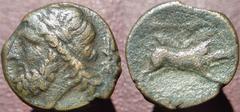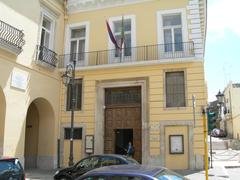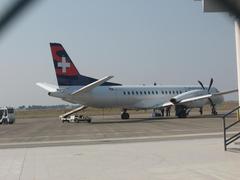
Foggia Cathedral: Visiting Hours, Tickets, and Historical Sites in Foggia
Date: 04/07/2025
Introduction
Foggia Cathedral—officially the Cathedral Basilica of Santa Maria Assunta in Cielo—stands as one of the most iconic religious, cultural, and architectural landmarks in Apulia, Italy. With a history spanning centuries, the cathedral is renowned not only for its stunning Romanesque and Baroque architecture but also for housing the revered Madonna Iconavetere (Black Madonna), a central focus of pilgrimage and local identity. This guide offers a comprehensive overview of the cathedral’s historical development, architectural highlights, visiting hours, ticketing, accessibility, and nearby attractions, ensuring visitors have all the information needed for a meaningful experience in Foggia.
For latest updates and official details, consult resources like Religiana, Visit Puglia, and Understanding Italy.
Historical Overview
Early Origins and Foundation
The roots of Foggia Cathedral are deeply intertwined with the discovery of the Madonna Iconavetere in the 11th century. Local tradition recounts that this mysterious Marian icon, veiled and floating in marshland, was found at the site where the cathedral would be established. The first sanctuary, commissioned by Norman leader Roberto il Guiscardo in 1081, was built to house the icon and now forms the crypt (Succorpo) beneath the present-day church.
Romanesque and Norman Expansion
In 1172, under William II of Sicily, a larger Romanesque church was constructed above the crypt to accommodate growing numbers of pilgrims. The Romanesque façade, with its robust stonework, rounded arches, and decorative reliefs, survives as a testament to Apulian craftsmanship. Notable is the stonework by Bartolomeo da Foggia, visible in the portal of San Martino.
Swabian, Imperial, and Baroque Transformations
The 13th century brought further prominence as the cathedral became associated with Frederick II, the Holy Roman Emperor. During the 18th century, a devastating earthquake prompted extensive Baroque renovations, blending rich stucco, frescoes, and ornamentation with the older Romanesque elements—a visual reflection of the cathedral’s layered history.
Artistic and Civic Significance
The Madonna Iconavetere remains the spiritual heart of Foggia, drawing pilgrims from across Italy, particularly during the annual Festa della Madonna dei Sette Veli in March. The cathedral also hosts major civic ceremonies and festivals, marking it as a hub of community life.
Architectural and Artistic Highlights
Exterior Features
- Romanesque Façade: Characterized by solid masonry, rounded arches, blind arcades, and semi-columns, with Pisan influences visible in the arrangement and ornamentation (Wikipedia; Religiana).
- Bell Tower: The 58-meter-high tower is a city landmark, combining Romanesque solidity with hints of Gothic verticality. Visitors can climb for panoramic city views (Outdooractive).
- Baroque Restoration: The 1731 earthquake led to Baroque additions, including dynamic stucco work and gilded details (Religiana).
Interior Features
- Nave and Layout: Follows a Latin cross plan, with a nave flanked by aisles and supported by columns featuring a range of sculpted capitals (Religiana).
- Baroque Altars: Richly decorated with gilding and polychrome marble, these altars enhance the devotional ambiance (Outdooractive).
- Stained Glass Windows: Colorful windows filter light, casting vibrant hues across the interior.
- Artworks: The cathedral houses paintings, sculptures, and the venerated “Virgin of the Seven Veils” icon (Religiana).
Notable Chapels and Details
- Chapel of the Rosary: Features marble altars and Marian artworks.
- Chapel of the Holy Sacrament: Adorned with frescoes and gilded decor.
- Crypt: The original sanctuary, home to the Madonna Iconavetere (Italy Time).
Comparative Context
Foggia Cathedral shares architectural features with other Apulian Romanesque churches, such as those in Troia, including blind arches and rose windows, but with its own unique blend of influences (Catholic Shrine Basilica).
Religious Significance and Pilgrimage
Madonna Iconavetere (Black Madonna)
Central to the cathedral’s spiritual identity, the Black Madonna (Iconavetere) is housed in a dedicated chapel and revered for her miraculous discovery and protective symbolism. The annual Festa della Madonna dei Sette Veli in March is the focal point of Marian devotion, blending processions, prayers, and local traditions (Understanding Italy; Italien Expert).
Jubilee and Pilgrimage
During special years such as the Jubilee of 2025, the cathedral is designated as a pilgrimage site for plenary indulgences, with additional liturgical celebrations, confession times, and the symbolic opening of the Holy Door (Visit Puglia).
Visitor Information
Visiting Hours
Opening hours may vary slightly by source and season, but generally are:
- Monday to Saturday: 8:30 AM – 12:00 PM and 5:30 PM – 8:00 PM
- Saturday: Evening hours may extend to 10:00 PM
- Sunday: 8:30 AM – 1:00 PM and 5:30 PM – 8:00 PM
(christianedirectory.com)
During special events or holidays, check the official website for updates.
Tickets and Guided Tours
- Admission: Free; donations are encouraged.
- Guided Tours: Bookable in advance online or via the parish office. Some special exhibitions or bell tower climbs may require a small fee (Italien Expert).
Accessibility
- Wheelchair Access: Ramps at the entrance; accessible restrooms; assistance available upon request.
- Mobility: Interior is generally accessible, though some historic areas may have uneven floors.
Dress Code and Conduct
Modest attire (shoulders and knees covered) is required. Silence and respectful behavior are expected, especially during services.
Photography
Photography without flash is generally permitted; check for posted signs or ask staff for restrictions during ceremonies.
Travel Tips and Nearby Attractions
- Location: Piazza Pericle Felici, 71121 Foggia FG, Italy—central in the historic district, close to major accommodations and public transport (visit.puglia.it).
- Getting There:
- By Air: Bari and Naples are the nearest airports.
- By Train: Foggia Railway Station is a 15–20 minute walk from the cathedral.
- By Car: Well-connected by highway; parking available nearby (christianedirectory.com).
- Nearby Sights:
- Museo Civico di Foggia
- Palazzo Dogana
- Villa Comunale Karol Wojtyła
- Sanctuary of Saint Mary our Lady of Grace
- Local markets and eateries (thetouristchecklist.com, try-travel.com).
Community, Festivals, and Social Role
Foggia Cathedral is a center for local life, hosting baptisms, weddings, funerals, and civic events. The Festa della Madonna dei Sette Veli and other religious celebrations blend sacred and communal traditions, with processions, music, and shared meals (Understanding Italy; Travel to Italy Guide).
The cathedral is also active in charity and outreach—organizing food drives, supporting marginalized groups, and facilitating community events, especially during Jubilee years (Visit Puglia).
Frequently Asked Questions (FAQ)
Q: What are Foggia Cathedral’s visiting hours?
A: Generally, Monday to Saturday 8:30 AM – 12:00 PM and 5:30 PM – 8:00 PM; Sunday 8:30 AM – 1:00 PM and 5:30 PM – 8:00 PM. Check for special hours during festivals or holidays.
Q: Is there an entrance fee?
A: Admission is free; donations are appreciated. Some guided tours or exhibitions may require a ticket.
Q: Are guided tours available?
A: Yes, bookable via the official website or parish office.
Q: Is the cathedral accessible for visitors with disabilities?
A: Yes, with ramps and accessible facilities, though some historic areas may have uneven flooring.
Q: Can I take photographs inside?
A: Yes, but avoid flash and tripods. Always check posted signage.
Practical Tips
- Best Times to Visit: Early mornings or late afternoons are quieter; major festivals offer a vibrant cultural experience.
- Dress Code: Modest clothing required.
- Facilities: Restrooms may be limited; cafés and shops are nearby.
- Language: Italian is the primary language, but some staff speak English.
Summary Table: Foggia Cathedral at a Glance
| Aspect | Details |
|---|---|
| Central Relic | Madonna Iconavetere (Black Madonna) |
| Pilgrimage Status | Major Marian shrine; Jubilee pilgrimage site |
| Key Festival | Festa della Madonna dei Sette Veli (March) |
| Architectural Style | Romanesque origins, Baroque reconstruction |
| Community Role | Worship, cultural events, charity, civic life |
| Artistic Heritage | Frescoes, sculptures, crypt, 18th-century organ |
| Social Outreach | Food drives, support for marginalized groups, Jubilee acts of mercy |
| Integration with Local Life | Processions, agricultural festivals, educational programs |
Visuals and Media
High-quality images of the façade, bell tower, interior, and Madonna Iconavetere enhance the visitor experience. Interactive virtual tours and maps are available on official tourism sites.
Conclusion and Call to Action
Foggia Cathedral is not only a masterpiece of Romanesque and Baroque architecture but also a living symbol of faith, resilience, and community. Whether your interest lies in art, history, or spirituality, a visit to this landmark offers an immersive experience into the heart of Apulian heritage.
Plan your visit today:
- Check current hours and events via official channels.
- Download the Audiala app for audio tours and up-to-date information.
- Follow us on social media for news on festivals, exhibitions, and guided tours.
For further information, visit the official tourism portal and local guides.
Sources and Further Reading
- Religiana: Foggia Cathedral
- Visit Puglia: Jubilee Sites
- Understanding Italy: Foggia
- Wikipedia: Foggia Cathedral
- Outdooractive: Religious Buildings in Foggia
- Christianedirectory: Cathedral of Foggia
- The Tourist Checklist: Things to do in Foggia
- Italien Expert: Foggia in Apulia
- Italy Time: Foggia
- Catholic Shrine Basilica: Troia Cathedral
- Try Travel: Things to do in Foggia
- Spotting History: Foggia Cathedral
- Triplyzer: Things to do in Foggia





